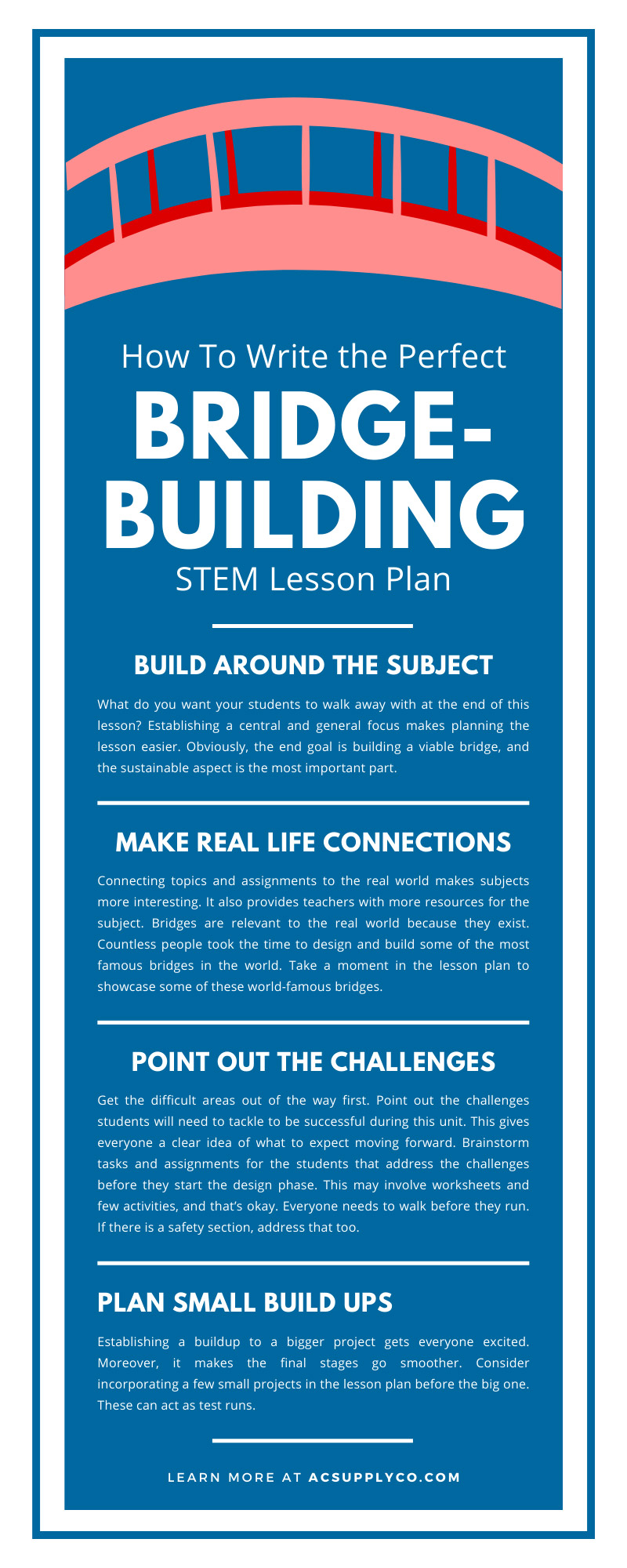Lesson plans help educators stay on course with the curriculum. There might be moments throughout the school year where the lessons deviate from certain subjects, but for the most part, they provide a solid base and overview of how the year will go.
When it comes to complex subjects, you’ll want to follow a lesson plan that’s easily understood and fun. For STEM classes, there should be plenty of projects because this is the area where students can get more hands-on experience. Here’s how to write the perfect bridge-building STEM lesson plan.
Build Around the Subject
What do you want your students to walk away with at the end of this lesson? Establishing a central and general focus makes planning the lesson easier. Obviously, the end goal is building a viable bridge, and the sustainable aspect is the most important part.
Students will need to turn their attention to what makes bridges enduring and force them to think outside of the box. This might be the area that requires the most buildup. Provide worksheets to your students that go over calculations they’ll use for their models. Building bridges is the perfect combination of math and science.
Because of this scholarly combination, there might be room for teachers in different departments to collaborate. Students will get further education in both the math and science departments and apply what they learn to both subjects.
Make Real Life Connections
Connecting topics and assignments to the real world makes subjects more interesting. It also provides teachers with more resources for the subject. Bridges are relevant to the real world because they exist. Countless people took the time to design and build some of the most famous bridges in the world.
Take a moment in the lesson plan to showcase some of these world-famous bridges. Point out challenges the designers and builders faced. Ask your students why they think the initial designs failed or why the construction faced trouble.
Some of these questions and responses could also apply to other architectural designs aside from bridges. This section may seem historical, but context is important when teaching the successes and failures. When your students start building model bridges, they can recall solutions to certain problems.
Point Out the Challenges
Get the difficult areas out of the way first. Point out the challenges students will need to tackle to be successful during this unit. This gives everyone a clear idea of what to expect moving forward.
Brainstorm tasks and assignments for the students that address the challenges before they start the design phase. This may involve worksheets and few activities, and that’s okay. Everyone needs to walk before they run. If there is a safety section, address that too.
Model bridges are relatively safe, but there are dangers to miscalculations in the real world. This is not something your students need to worry too much about, but it doesn’t hurt to mention this fact. The worse accident they can experience with their model bridge is a collapse.
Plan Small Build Ups
Establishing a buildup to a bigger project gets everyone excited. Moreover, it makes the final stages go smoother. Consider incorporating a few small projects in the lesson plan before the big one. These can act as test runs.
It’s also a good idea to include a few trial runs so students can understand their mistakes. Chances are their first designs will fail in some way. That’s just a part of the process. Make sure you have plenty of supplies to conduct test runs properly.
Here at AC Supply, we have bridge-building kits for schools that teachers can purchase for their students. Incorporating these kits into your STEM lesson plan is the perfect way to keep your students engaged in the subject.
Work in Teams
Teamwork makes the dream work, so assign the students to teams. Base the size of the group on the number of students and the complexity of the subject. Model bridge projects usually do not require more than four participants, and sometimes students can accomplish it with only two.
Avoid solitary work for this lesson. Your students will face some challenges, so it’s important for them to bounce ideas off teammates to create solutions. Additionally, building a bridge for the first time is a lot of work. Plenty of model hobbyists do this activity alone, but they also have more experience than your students.
The team-building portion can go beyond the hands-on aspect. Consider forming teams during the research portion of the lesson plan. Students should research which design they plan to use for their project. Organize class presentations delving into which design each team chose and why. Furthermore, encourage them to address what problems they think they might face along the way.
Make It a Competition
Always encourage healthy competition—it motivates students in the best way. Include an incentive at the end of the lesson. Of course, getting a good grade is plenty of motivation, but sometimes students need a harder nudge.
You can choose from several prizes to give to the best designers in your class. Make the grand prize something the students will enjoy but also pertains to the lesson plan. It should be educational and exciting.
One of the prizes could be a chance to enter a balsa wood bridge national and regional competition. Those tend to have favorable results and provide students with additional educational opportunities for their future.
Encourage Creativity
When students think outside the box, they start to teach themselves. Encourage as much creativity as possible. Maybe they want to add enhancements to the most successful bridge designs.
Challenges will force your students to brainstorm innovative solutions. They learn more about the subject, and they can even help you make it a teachable moment for the rest of the class. Additionally, student creativity can be a lesson for future classes.
Perfecting your bridge-building STEM lesson plan takes a little time and a lot of room for hands-on activities. We can help you in both areas. For more information, visit our website.



